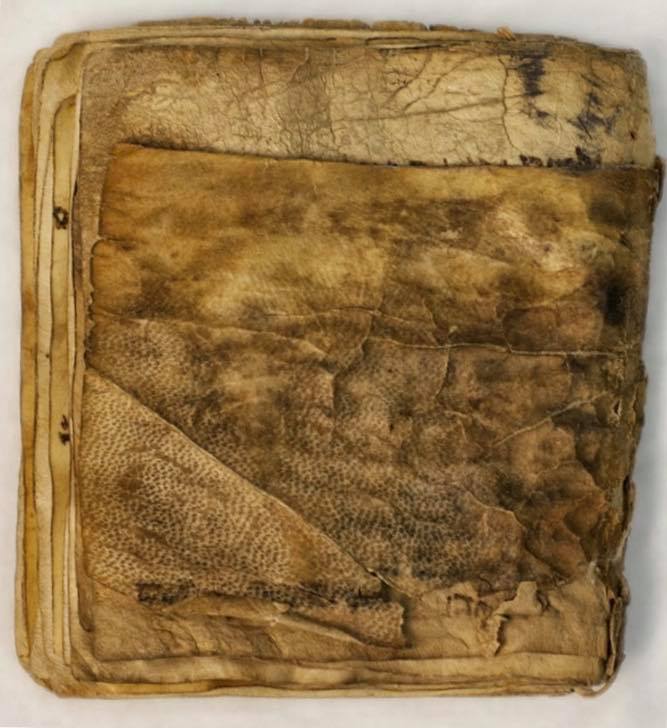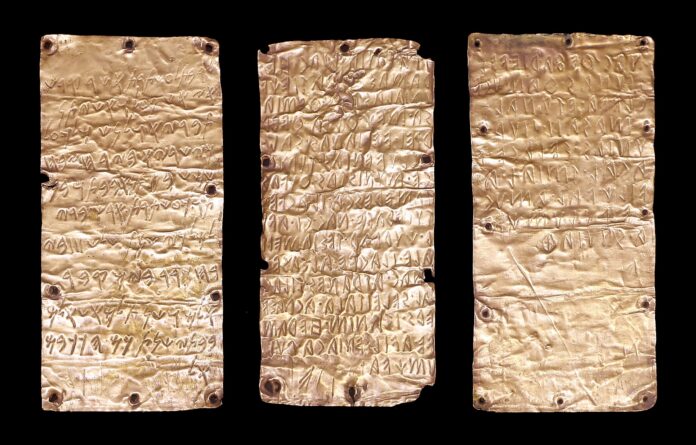- One of the oldest book in the world discovered in Spain in 1860, The Madrid Codex . The book is written in Yucatecan. (494 years old). The Codex was made from a long strip of amate paper that was folded up accordion-style. This paper was then coated with a thin layer of fine stucco, which was used as the painting surface. The complete document consists of 56 sheets painted on both sides to produce a total of 112 pages. The Troano is the larger part, consisting of 70 pages comprising pages 22–56 and 78–112. It takes its name from Juan Tro y Ortolano. The remaining 42 pages were originally known as the Cortesianus Codex, and include pages 1–21 and 57–77. Each page measures roughly 23.2 by 12.2 centimetres (9.1 by 4.8 in).
2. Gutenberg Bible, also known as the 42-line Bible, is listed by the Guinness Book of World records as the world’s oldest mechanically printed book – the first copies of which were printed in 1454-1455. (559 years old). The Gutenberg Bible, an edition of the Vulgate, contains the Latin version of the Hebrew Old Testament and the Greek New Testament. It is mainly the work of Jerome who began his work on the translation in 380 AD, with emendations from the Parisian Bible tradition, and further divergences (the Paris Bible, one of many Bible translations in the Middle Ages, is also known as the “Thirteenth-Century Bible”, “Old French Bible” or, in French, Bible du XIIIe siècle).
3. Celtic Psalter: The book is thought to be have been created in the 11th century, making it Scotland’s oldest surviving book. ( 938 years old). The Irish miniscule script is bold and clear and it gives a text of the Psalms in Latin that can still be read today.
4. Diamond Sūtra: Found in a walled up cave in China along with other printed materials. A Buddhist holy text, the Diamond Sūtra is considered to be the oldest surviving dated printed book in the world. (1,145 years old.) A copy of the Tang-dynasty Chinese version of the Diamond Sūtra was found among the Dunhuang manuscripts in 1900 by Daoist monk Wang Yuanlu and sold to Aurel Stein in 1907. They are dated back to 11 May 868. It is, in the words of the British Library, “the earliest dated printed book”. It is also the first known creative work with an explicit public-domain dedication, as its colophon at the end states that it was created “for universal free distribution”.
5. Siddur, Jewish Prayer Book- is so old that it contains Babylonian vowel pointing – akin to the Old or Middle English for the English language. ( 1,173 years old.) The earliest parts of Jewish prayer books are the Shema Yisrael (“Hear O Israel”) (Deuteronomy 6:4 et seq) and the Priestly Blessing (Numbers 6:24-26), which are in the Torah. A set of eighteen (currently nineteen) blessings called the Shemoneh Esreh or the Amidah (Hebrew, “standing [prayer]”), is traditionally ascribed to the Great Assembly in the time of Ezra, at the end of the biblical period.
6. Book of Kells: The Book of Kells is kept in the Trinity College Library in Dublin, Ireland, and is thought to have been created by Celtic monks around . (1,213 years old.) The illustrations and ornamentation of the Book of Kells surpass that of other Insular Gospel books in extravagance and complexity. The decoration combines traditional Christian iconography with the ornate swirling motifs typical of Insular art. Figures of humans, animals and mythical beasts, together with Celtic knots and interlacing patterns in vibrant colours, enliven the manuscript’s pages. Many of these minor decorative elements are imbued with Christian symbolism and so further emphasise the themes of the major illustrations.
7. St Cuthbert Gospel: Europe’s oldest known surviving intact book is the St Cuthbert Gospel. The book was buried with St Cuthbert, an early British Christian leader. (1,315 years old.) The book takes its name from Saint Cuthbert of Lindisfarne, North East England, in whose tomb it was placed, probably a few years after his death in 687. Although it was long regarded as Cuthbert’s personal copy of the Gospel, to which there are early references, and so a relic of the saint, the book is now thought to date from shortly after Cuthbert’s death. It was probably a gift from Monkwearmouth–Jarrow Abbey, where it was written, intended to be placed in St Cuthbert’s coffin in the few decades after this was placed behind the altar at Lindisfarne in 698. It presumably remained in the coffin through its long travels after 875, forced by Viking invasions, ending at Durham Cathedral. The book was found inside the coffin and removed in 1104 when the burial was once again moved within the cathedral. It was kept there with other relics, and important visitors were able to wear the book in a leather bag around their necks. It is thought that after the Dissolution of the Monasteries in England by Henry VIII between 1536 and 1541, the book passed to collectors. It was eventually given to Stonyhurst College, the Jesuit school in Lancashire.
8. Nag Hammadi Library: Considered to be some of the oldest surviving bound books – 13 leather bound papyrus codices were discovered in 1945 buried inside a sealed jar, by a local man in the town of Nag Hammadi in Upper Egypt. (1,693 years old.) Thirteen leather-bound papyrus codices buried in a sealed jar were found by a local farmer named Muhammed al-Samman. The writings in these codices comprise 52 mostly Gnostic treatises, but they also include three works belonging to the Corpus Hermeticum and a partial translation/alteration of Plato’s Republic. In his introduction to The Nag Hammadi Library in English, James Robinson suggests that these codices may have belonged to a nearby Pachomian monastery and were buried after Saint Athanasius condemned the use of non-canonical books in his Festal Letter of 367 A.D. The discovery of these texts significantly influenced modern scholarship’s pursuit and knowledge of early Christianity and Gnosticism.
9. Pyrgi Gold Tablets: Found in 1964 in the excavation of a sanctuary in ancient Pyrgi, Italy. (2,513 years old.). Two of the tablets are inscribed in the Etruscan language, the third in Phoenician. The writings are important in providing both a bilingual text that allows researchers to use knowledge of Phoenician to interpret Etruscan, and evidence of Phoenician or Punic influence in the Western Mediterranean. They may relate to Polybius’s report (Hist. 3,22) of an ancient and almost unintelligible treaty between the Romans and the Carthaginians, which he dated to the consulships of Lucius Junius Brutus and Lucius Tarquinius Collatinus (509 BC).
10. Etruscan Gold Book: The book is made from 6 sheets of 24 carat gold, bound together with rings. Etruscans were an ancient race of people that migrated from Lydia – in now what would be modern Turkey . (2,673 years old.). The content of the book suggests that it was made for the funeral of an aristocrat who was a member of the Orpheus cult.1 The Greek philosopher Pythagoras spread the beliefs of the cult (which originated in Thracia) in southern Italy and among the neighboring Etruscan tribes. According to Penkova, about 30 pages from Etruscan books are known from elsewhere, but only in single sheets. The Bulgarian find is the only complete version.









Views: 382






